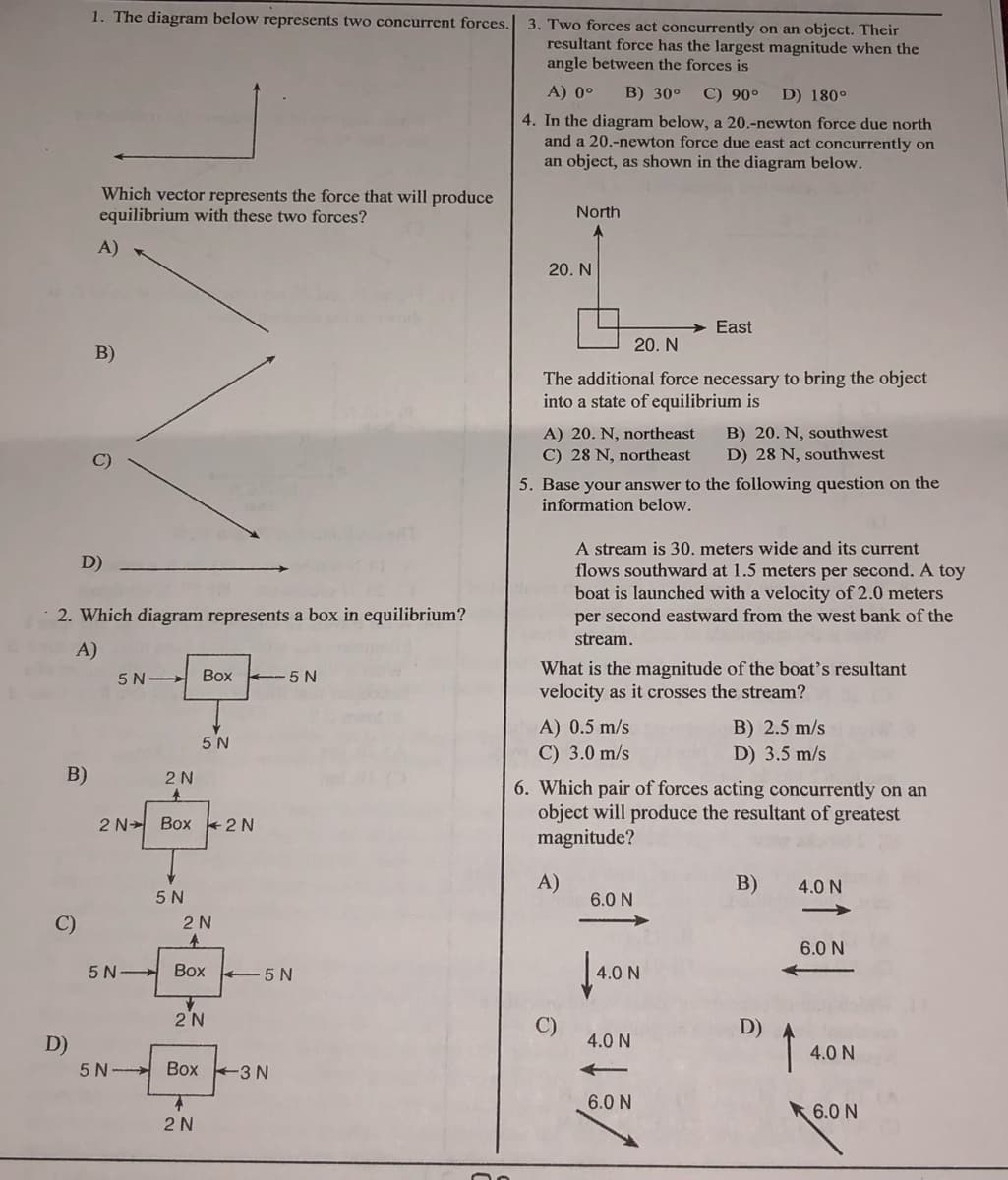1. The diagram below represents two concurrent forces. Which vector represents the force that will produce equilibrium with these two forces? A) B) C) D)
1. The diagram below represents two concurrent forces. Which vector represents the force that will produce equilibrium with these two forces? A) B) C) D)
Glencoe Physics: Principles and Problems, Student Edition
1st Edition
ISBN:9780078807213
Author:Paul W. Zitzewitz
Publisher:Paul W. Zitzewitz
Chapter5: Displacement And Force In Two Dimensions
Section: Chapter Questions
Problem 83A
Related questions
Topic Video
Question
help with these questions & show all work

Transcribed Image Text:1. The diagram below represents two concurrent forces.
3. Two forces act concurrently on an object. Their
resultant force has the largest magnitude when the
angle between the forces is
A) 0°
B) 30°
C) 90°
D) 180°
4. In the diagram below, a 20.-newton force due north
and a 20.-newton force due east act concurrently on
an object, as shown in the diagram below.
Which vector represents the force that will produce
equilibrium with these two forces?
North
A)
20. N
> East
20. N
B)
The additional force necessary to bring the object
into a state of equilibrium is
A) 20. N, northeast
C) 28 N, northeast
B) 20. N, southwest
D) 28 N, southwest
5. Base your answer to the following question on the
information below.
A stream is 30. meters wide and its current
D)
flows southward at 1.5 meters per second. A toy
boat is launched with a velocity of 2.0 meters
per second eastward from the west bank of the
2. Which diagram represents a box in equilibrium?
stream.
A)
What is the magnitude of the boat's resultant
velocity as it crosses the stream?
5N
Box
5 N
A) 0.5 m/s
C) 3.0 m/s
B) 2.5 m/s
D) 3.5 m/s
5 N
B)
2N
6. Which pair of forces acting concurrently on an
object will produce the resultant of greatest
magnitude?
2 N- Box 2 N
A)
B)
4.0 N
5 N
6.0 N
>
C)
2 N
6.0 N
5 N Box
- 5 N
4.0 N
2 N
D)
D)
4.0 N
4.0 N
5 N
Box 3 N
6.0 N
* 6.0 N
2 N
Expert Solution
This question has been solved!
Explore an expertly crafted, step-by-step solution for a thorough understanding of key concepts.
This is a popular solution!
Trending now
This is a popular solution!
Step by step
Solved in 2 steps with 2 images

Knowledge Booster
Learn more about
Need a deep-dive on the concept behind this application? Look no further. Learn more about this topic, physics and related others by exploring similar questions and additional content below.Recommended textbooks for you

Glencoe Physics: Principles and Problems, Student…
Physics
ISBN:
9780078807213
Author:
Paul W. Zitzewitz
Publisher:
Glencoe/McGraw-Hill


College Physics
Physics
ISBN:
9781305952300
Author:
Raymond A. Serway, Chris Vuille
Publisher:
Cengage Learning

Glencoe Physics: Principles and Problems, Student…
Physics
ISBN:
9780078807213
Author:
Paul W. Zitzewitz
Publisher:
Glencoe/McGraw-Hill


College Physics
Physics
ISBN:
9781305952300
Author:
Raymond A. Serway, Chris Vuille
Publisher:
Cengage Learning

College Physics
Physics
ISBN:
9781285737027
Author:
Raymond A. Serway, Chris Vuille
Publisher:
Cengage Learning

College Physics
Physics
ISBN:
9781938168000
Author:
Paul Peter Urone, Roger Hinrichs
Publisher:
OpenStax College